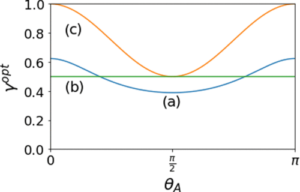V. P. Michal and Y. V. Nazarov
Phys. Rev. B 100, 045416 – Published 22 July 2019
ABSTRACT:  We address the interaction between two quantum systems (A and B) that is mediated by their common linear environment. If the environment is out of equilibrium, the resulting interaction violates Onsager relations and cannot be described by a Hamiltonian. In simple terms, the action of system A on system B does not necessarily produce a back action. We derive general quantum equations describing the situation, and we analyze in detail their classical correspondence. Changing the properties of the environment, one can easily change and engineer the resulting interaction. It is tempting to use this for quantum manipulation of the systems. However, the resulting quantum gate is not always unitary and may induce a loss of quantum coherence. For a relevant example, we consider systems A and B to be spins of arbitrary values and arrange the interaction to realize an analog of the two-qubit cnot gate. The direction of spin A controls the rotation of spin B while spin A is not rotated experiencing no back action from spin B. We solve the quantum dynamics equations and analyze the purity of the resulting density matrix. The resulting purity essentially depends on the initial states of the systems. We attempt to find a universal characteristic of the purity, optimizing it for the worst choice of initial states. For both spins
We address the interaction between two quantum systems (A and B) that is mediated by their common linear environment. If the environment is out of equilibrium, the resulting interaction violates Onsager relations and cannot be described by a Hamiltonian. In simple terms, the action of system A on system B does not necessarily produce a back action. We derive general quantum equations describing the situation, and we analyze in detail their classical correspondence. Changing the properties of the environment, one can easily change and engineer the resulting interaction. It is tempting to use this for quantum manipulation of the systems. However, the resulting quantum gate is not always unitary and may induce a loss of quantum coherence. For a relevant example, we consider systems A and B to be spins of arbitrary values and arrange the interaction to realize an analog of the two-qubit cnot gate. The direction of spin A controls the rotation of spin B while spin A is not rotated experiencing no back action from spin B. We solve the quantum dynamics equations and analyze the purity of the resulting density matrix. The resulting purity essentially depends on the initial states of the systems. We attempt to find a universal characteristic of the purity, optimizing it for the worst choice of initial states. For both spins
the optimized purity is bounded by 1/2 irrespective of the details of the gate. We also study in detail the semiclassical limit of large spins. In this case, the optimized purity is bounded by 0.39. This is much better than the typical purity of a large spin state.
We conclude that although the quantum manipulation without back action inevitably causes decoherence of the quantum states, the actual purity of the resulting state can be optimized and made relatively high.
